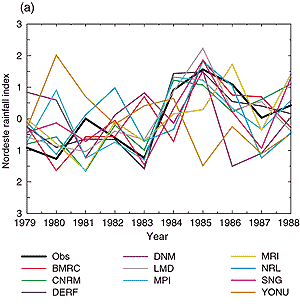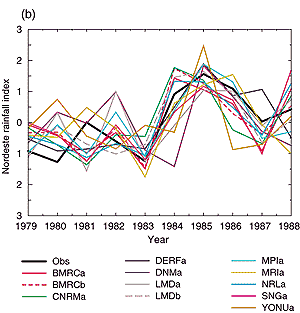

Figure 8.23: Simulated (March-May) and observed (March-April) averaged Nordeste (north-eastern Brazil) rainfall indices for (a) the original AMIP simulations, (b) the revised AMIP simulations (Sperber et al., 1999).
Monsoon constitutes an essential phenomenon for a tropical climate (see Chapter 7, Section 7.6.3). The monsoon precipitation simulated by AGCMs has been evaluated in AMIP (Sperber and Palmer, 1996; Zhang et al., 1997; Gadgil and Sajani, 1998). The seasonal migration of the major rain belt over the West African region is well simulated by almost all models. However coarse resolution climate models generally fail to give satisfactory simulations of the East Asian, East African and North American monsoons (Stensrud et al., 1995; Lau and Yang, 1996; Semazzi and Sun, 1997; Yu et al., 2000b). For example, models have excessive precipitation in the eastern periphery of the Tibetan Plateau. Increase of horizontal resolution can improve the precipitation details, but may not be sufficient to remove large-scale model biases (Kar et al., 1996; Lal et al., 1997; Stephenson et al., 1998; Chandrasekar et al., 1999; Martin, 1999; also see Section 8.9.1).
Interannual variations of Nordeste (north-eastern Brazil) rainfall are well captured with atmospheric models with prescribed interannually varying SST (Potts et al., 1996; Sperber and Palmer, 1996). This is also the case for the South American monsoon (Robertson et al., 1999) and the West African monsoon (Rowell et al., 1995; Semazzi et al., 1996; Rocha and Simmonds, 1997; Goddard and Graham, 1999). The precipitation variation over India is less well simulated. However the models show better skill in reproducing the interannual variability of a wind shear index over the Indian summer monsoon region, indicating that the models exhibit greater fidelity in capturing the large-scale dynamic fluctuations than the regional scale rainfall variations.
More recent atmospheric models with revised physical parametrizations show improved interannual variability of the all-India rainfall, Indian/Asian monsoon wind shear, Sahel and Nordeste rainfall (Figure 8.23) (Sperber et al., 1999). Improvement in the simulation of interannual variability is associated with a better simulation of the observed climate by the models (Sperber and Palmer, 1996; Ferranti et al., 1999; Martin and Soman, 2000). The observed rainfall/ENSO SST correlation pattern is better simulated by those models that have a rainfall climatology in closer agreement with observations (Gadgil and Sajani, 1998).
Coupled climate models that simulate El Niño-like SST variability in the tropical Pacific indicate a strong connection between ENSO and the strength of the Indian summer monsoon in qualitative agreement with observations (Meehl and Arblaster, 1998; Kitoh et al., 1999; Latif et al., 1999). Besides the ENSO time-scale, the South Asian monsoon reveals a strong biennial oscillation. Coupled models can reproduce this tropospheric biennial oscillation (TBO) (Meehl, 1997; Ogasawara et al., 1999).
MJO is a 30 to 60 day oscillation that moves eastward in the tropical large-scale circulation, and affects both mid-latitude atmospheric circulation and the Asian-Australian monsoon. Slingo et al. (1996) showed that nearly all of the AMIP models have power in the intra-seasonal time-scale of equatorial upper troposphere zonal wind at higher frequencies than the observation. They also show that most models underestimated the strength of the MJO. Slingo et al. (1999) show that the HadAM3 model forced by the observed SST displays a decadal time-scale variability of MJO activity as observed, implying a possible link between long-term changes of tropical SST and MJO activity, and also the ability of a current atmospheric model to simulate it.
Recent studies suggest an important role of air-sea interaction on the intra-seasonal time-scale phenomena (Flatau et al., 1997; Waliser et al., 1999; Li and Yu, 2001), thus a possible improvement in reproducing the MJO by coupled climate models. This warrants a need to evaluate the MJO in coupled climate models, but this is yet to be undertaken.
The North Atlantic Oscillation (NAO) is a regional mode of variability over the North Atlantic, while the Arctic Oscillation (AO) is a hemispheric mode of variability which resembles in many respects the NAO (see Chapter 7, Section 7.6.4). Coupled climate models simulate the NAO quite well, although there are some differences in its amplitude (Delworth, 1996; Laurent et al., 1998; Saravanan, 1998; Osborn et al., 1999). Atmospheric models with prescribed SST also simulate the spatial pattern of NAO variability fairly well (Rodwell et al., 1999), although coupling to an interactive ocean does seem to produce the most realistic NAO pattern. A realistic AO is simulated in the CCCma (Fyfe et al., 1999), GISS (Shindell et al., 1999) and GFDL (Broccoli et al., 1998) climate models. The AO extends into the mid-troposphere to lower stratosphere where it is associated with variations in westerly wind speed (see Chapter 2, Section 2.6.5 and Chapter 7, Section 7.6.4). This coupled troposphere-stratosphere mode of internal variability has been reproduced in the Meteorological Research Institute (MRI) coupled climate model (Kitoh et al., 1996; Kodera et al., 1996).
|
Other reports in this collection |